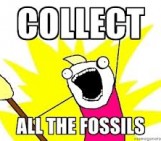Welcome to the fourth International Palaeontology Congress! 900 palaeontologists have piled into the land of steak, sun, and malbec in Mendoza, Argentina, for the biggest palaeontology conference that draws from all parts of the field.
What I want to do with these posts is just provide snapshot summaries of the talks I’ve been at to provide a window into the conference and the amazing diversity of research being conducted by a global team of awesome researchers. It’s not all just dinosaurs you know! Results will not be discussed in any detail for obvious reasons.
The first symposium I attended was on the “Coevolution of the Earth and life: the role of the physical environment in species’ evolution.”
Seth Finnegan kicked things of asking how the fossil record can inform conservation planning. By combining information on past climate change, and the life histories of organisms, you can begin to unpick the drivers of extinction and which organisms are at the greatest risk. Range contraction and expansion seem pretty important in predicting extinction risk, especially in groups of microfossils.
L. Lacey Knowles moved into integrating molecular data, fossils, and palaeoclimatic data to look at population changes through time. Looking at plants in the Rocky Mountains, she asked do closely related plant species occupy different ecologies respond differently to climate change; for example, through glacial expansion and contraction. Additionally, in Australian lizards, population history (in terms of distribution and bioclimatic data) appears to be a strong predictor of their current distributions.
Corinne Myers explored the role of abiotic factors and climate change and how they affect species’ range size and speciation and extinction patterns. Differences in species occupation ranges strongly affect their ability to disperse, which may have further implications for their extinction selectivity.
Martin Aberhan moved into larger scale historical trends, asking what the biotic and abiotic factors that drive specialisation in Phanerozoic marine invertebrates are. By looking at how aspects such as substrate and grain size (parameters describing habitat from the geological record) correspond to standardised diversity, as well as extinction and origination rates, it seems that through time specialist organisms tend to have a higher origination rate than generalists. This suggests that specialist genera have a tendency to diversify faster to occupy niche space. Abiotic factors such as sea-level and temperature appear to not correlate with the proportion of specialist genera.
Erin Saupe discussed how niche breadth and geographic range size affects species’ survival rates. Both geographic range size and environmental range of fossil lineages from the Pliocene, a time when it was much warmer, seem to affect survivability in modern day molluscs.
Alycia Stigall finished the symposium by asking what the link is between species’ invasions and environmental change, and the stability of a species’ niche.
That’s it for the morning session! I think it really highlighted the importance of looking at the past to inform and develop our models for extinction risk and conservation management, in a time when we are undoubtedly going through a global biodiversity crisis.


Pingback: IPC4 Day 1 – Death is the road to awe | Green Tea and Velociraptors